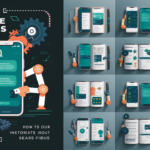In today’s digital landscape, mobile apps have become an integral part of our daily lives. From shopping and social networking to productivity and entertainment, mobile apps offer convenience and functionality at our fingertips. However, not all apps provide a seamless user experience. To truly stand out and engage users, optimizing your mobile app experience is crucial. Let’s explore the key strategies to create an app that users will love.
1. User-Centric Design
Put yourself in the user’s shoes. Prioritize user-centered design that focuses on simplicity, intuitive navigation, and clear user flows. A well-designed app anticipates user needs and provides a visually appealing and efficient interface.
2. Performance and Speed
App users have little patience for slow-loading or laggy apps. Optimize your app’s performance to ensure quick loading times and smooth interactions. Minimize unnecessary animations and reduce app size to enhance speed.
3. Personalization
Personalization enhances user engagement. Tailor the app experience to individual user preferences, such as recommending content based on past behavior or allowing users to customize their settings.
4. Seamless Onboarding
First impressions matter. A seamless onboarding process introduces users to your app’s features without overwhelming them. Keep it concise, interactive, and informative.
5. Regular Updates
Consistent updates demonstrate your commitment to enhancing the app experience. Address user feedback, fix bugs, and introduce new features to keep users engaged and excited.
6. Cross-Platform Compatibility
Optimize your app for different devices and operating systems. A responsive design ensures a consistent experience across smartphones, tablets, and even wearables.
7. Streamlined Navigation
Simplify navigation by using clear icons, menus, and labels. Intuitive navigation reduces user frustration and encourages exploration.
8. Accessibility
Ensure your app is accessible to all users, including those with disabilities. Implement features like text-to-speech and larger font options.
9. User Feedback and Testing
Regularly solicit user feedback to identify pain points and areas for improvement. Conduct thorough testing across various devices and scenarios to catch any usability issues.
10. Data Privacy and Security
Users value their privacy. Implement robust data protection measures and transparent privacy policies to build trust with your audience.
11. Offline Functionality
Design your app to provide basic functionality even when users are offline. This enhances the user experience and prevents frustration when connectivity is limited.
12. Analytics and Insights
Collect and analyze user data to gain insights into user behavior, preferences, and pain points. Use this data to make informed decisions for app optimization.
Conclusion
Optimizing your mobile app experience requires a deep understanding of user needs and a commitment to continuous improvement. By prioritizing user-centric design, performance, personalization, and security, you can create an app that not only stands out in a crowded market but also delivers an exceptional and memorable experience for your users.











п»їfarmacia online Levitra precio farmacia 24h